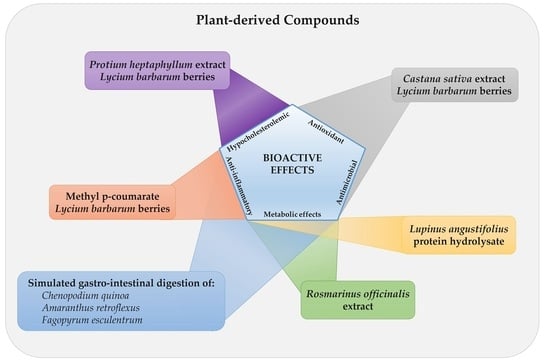Health Properties of Plant Bioactive Compounds: Immune, Antioxidant, and Metabolic Effects
Author Contributions
Funding
Conflicts of Interest
References
- Christopher, A.; Bartkowski, J.P.; Haverda, T. Portraits of veganism: A comparative discourse analysis of a second-order subculture. Societies 2018, 8, 55. [Google Scholar] [CrossRef] [Green Version]
- Martínez-Villaluenga, C.; Zieliński, H.; Frias, J.; Piskuła, M.K.; Kozłowska, H.; Vidal-Valverde, C. Antioxidant capacity and polyphenolic content of high-protein lupin products. Food Chem. 2009, 112, 84–88. [Google Scholar] [CrossRef]
- García, M.; Puchalska, P.; Esteve, C.; Marina, M. Vegetable foods: A cheap source of proteins and peptides with antihypertensive, antioxidant, and other less occurrence bioactivities. Talanta 2013, 106, 328–349. [Google Scholar] [CrossRef] [PubMed]
- Rivero-Pino, F.; Espejo-Carpio, F.J.; Guadix, E.M. Identification of dipeptidyl peptidase IV (DPP-IV) inhibitory peptides from vegetable protein sources. Food Chem. 2021, 354, 129473. [Google Scholar] [CrossRef] [PubMed]
- Streimikyte, P.; Viskelis, P.; Viskelis, J. Enzymes-Assisted Extraction of Plants for Sustainable and Functional Applications. Int. J. Mol. Sci. 2022, 23, 2359. [Google Scholar] [CrossRef] [PubMed]
- Ferreira, A.S.; Silva, A.M.; Pinto, D.; Moreira, M.M.; Ferraz, R.; Švarc-Gajić, J.; Costa, P.C.; Delerue-Matos, C.; Rodrigues, F. New Perspectives on the Sustainable Employment of Chestnut Shells as Active Ingredient against Oral Mucositis: A First Screening. Int. J. Mol. Sci. 2022, 23, 14956. [Google Scholar] [CrossRef] [PubMed]
- Capraro, J.; Benedetti, S.D.; Heinzl, G.C.; Scarafoni, A.; Magni, C. Bioactivities of pseudocereal fractionated seed proteins and derived peptides relevant for maintaining human well-being. Int. J. Mol. Sci. 2021, 22, 3543. [Google Scholar] [CrossRef] [PubMed]
- Mannino, G.; Iovino, P.; Lauria, A.; Genova, T.; Asteggiano, A.; Notarbartolo, M.; Porcu, A.; Serio, G.; Chinigò, G.; Occhipinti, A. Bioactive triterpenes of protium heptaphyllum gum resin extract display cholesterol-lowering potential. Int. J. Mol. Sci. 2021, 22, 2664. [Google Scholar] [CrossRef] [PubMed]
- Park, J.-W.; Choi, J.; Lee, J.; Park, J.-M.; Kim, S.-M.; Min, J.-H.; Seo, D.-Y.; Goo, S.-H.; Kim, J.-H.; Kwon, O.-K. Methyl P-Coumarate Ameliorates the Inflammatory Response in Activated-Airway Epithelial Cells and Mice with Allergic Asthma. Int. J. Mol. Sci. 2022, 23, 14909. [Google Scholar] [CrossRef] [PubMed]
- Santos-Sánchez, G.; Ponce-España, E.; López, J.C.; Álvarez-Sánchez, N.; Álvarez-López, A.I.; Pedroche, J.; Millán, F.; Millán-Linares, M.C.; Lardone, P.J.; Bejarano, I. A lupin (Lupinus angustifolius) protein hydrolysate exerts anxiolytic-like effects in Western diet-fed ApoE−/− mice. Int. J. Mol. Sci. 2022, 23, 9828. [Google Scholar] [CrossRef] [PubMed]
- Sutkowska-Skolimowska, J.; Brańska-Januszewska, J.; Strawa, J.W.; Ostrowska, H.; Botor, M.; Gawron, K.; Galicka, A. Rosemary Extract-Induced Autophagy and Decrease in Accumulation of Collagen Type I in Osteogenesis Imperfecta Skin Fibroblasts. Int. J. Mol. Sci. 2022, 23, 10341. [Google Scholar] [CrossRef] [PubMed]
- Teixeira, F.; Silva, A.M.; Delerue-Matos, C.; Rodrigues, F. Lycium barbarum Berries (Solanaceae) as Source of Bioactive Compounds for Healthy Purposes: A Review. Int. J. Mol. Sci. 2023, 24, 4777. [Google Scholar] [CrossRef] [PubMed]
- Cascaes, M.M.; Carneiro, O.D.S.; Nascimento, L.D.D.; de Moraes, Â.A.B.; de Oliveira, M.S.; Cruz, J.N.; Guilhon, G.M.S.P.; Andrade, E.H.D.A. Essential oils from annonaceae species from Brazil: A systematic review of their phytochemistry, and biological activities. Int. J. Mol. Sci. 2021, 22, 12140. [Google Scholar] [CrossRef] [PubMed]
- Khutami, C.; Sumiwi, S.A.; Khairul Ikram, N.K.; Muchtaridi, M. The Effects of Antioxidants from Natural Products on Obesity, Dyslipidemia, Diabetes and Their Molecular Signaling Mechanism. Int. J. Mol. Sci. 2022, 23, 2056. [Google Scholar] [CrossRef] [PubMed]
- Sharma, N.; Tan, M.A.; An, S.S.A. Phytosterols: Potential metabolic modulators in neurodegenerative diseases. Int. J. Mol. Sci. 2021, 22, 12255. [Google Scholar] [CrossRef] [PubMed]
- Ferreira, A.S.; Macedo, C.; Silva, A.M.; Delerue-Matos, C.; Costa, P.; Rodrigues, F. Natural Products for the Prevention and Treatment of Oral Mucositis—A Review. Int. J. Mol. Sci. 2022, 23, 4385. [Google Scholar] [CrossRef] [PubMed]
Disclaimer/Publisher’s Note: The statements, opinions and data contained in all publications are solely those of the individual author(s) and contributor(s) and not of MDPI and/or the editor(s). MDPI and/or the editor(s) disclaim responsibility for any injury to people or property resulting from any ideas, methods, instructions or products referred to in the content. |
© 2023 by the authors. Licensee MDPI, Basel, Switzerland. This article is an open access article distributed under the terms and conditions of the Creative Commons Attribution (CC BY) license (https://creativecommons.org/licenses/by/4.0/).
Share and Cite
Cruz-Chamorro, I.; Carrillo-Vico, A. Health Properties of Plant Bioactive Compounds: Immune, Antioxidant, and Metabolic Effects. Int. J. Mol. Sci. 2023, 24, 7916. https://doi.org/10.3390/ijms24097916
Cruz-Chamorro I, Carrillo-Vico A. Health Properties of Plant Bioactive Compounds: Immune, Antioxidant, and Metabolic Effects. International Journal of Molecular Sciences. 2023; 24(9):7916. https://doi.org/10.3390/ijms24097916
Chicago/Turabian StyleCruz-Chamorro, Ivan, and Antonio Carrillo-Vico. 2023. "Health Properties of Plant Bioactive Compounds: Immune, Antioxidant, and Metabolic Effects" International Journal of Molecular Sciences 24, no. 9: 7916. https://doi.org/10.3390/ijms24097916
APA StyleCruz-Chamorro, I., & Carrillo-Vico, A. (2023). Health Properties of Plant Bioactive Compounds: Immune, Antioxidant, and Metabolic Effects. International Journal of Molecular Sciences, 24(9), 7916. https://doi.org/10.3390/ijms24097916






